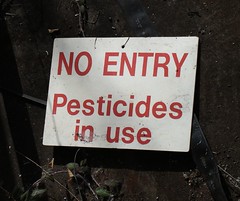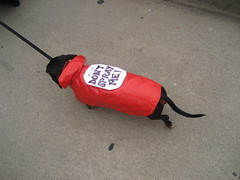Pesticides on airplanes
Friday, April 17th, 2009 Did you ever wonder why you always get sick after flying on an airplane only to be told, “it’s because of the recycled air and all the sick people sitting next to you”?
Did you ever wonder why you always get sick after flying on an airplane only to be told, “it’s because of the recycled air and all the sick people sitting next to you”?
Today I was talking to a client about my recent trip to Hawaii and being sick from the pesticides in the place we stayed. “You do know that they spray all the airplanes with pesticide also, ” she added.
I had no idea! At lunch I went home and turned to the internet to see what I could find and was shocked. Did you know that not only are the insides of most planes sprayed with pesticides between stops but some countries also spray the passengers of the plane with pesticides before arriving! (These countries include India, Jamaica, and Australia)
From the Mother Jones article, Danger in the Air :
The Northwest Coalition for Alternatives to Pesticide, an environmental group based in Eugene, Ore., points out that pesticides, while dangerous on land, cause even greater harm when used on planes, because up to 50 percent of the air inside the cabins is recycled. “Pesticides break down slowly in the enclosed, poorly ventilated aircraft,” says NCAP spokeswoman Becky Riley. “Passengers are sealed in a chamber that has been gassed, and sit there for hours.”
From the article, Airline Passengers Are Sprayed for Bugs on the Pesticide Action Network’s website :
 The airlines are not required to inform passengers at ticket purchase of flight sprays, and there is also no control over how much pesticide is applied on the aircraft. The Association of Flight Attendants reported in 2001 that one airline used 50-60% more pesticide than the maximum recommended by the World Health Organization. Between 2000 and 2001, one cabin crew union received complaints of pesticide-related illness on more than 200 flights. Many complaints cite damp surfaces and pesticide odors in crew rest compartments. Crews and passengers have reported sinus problems, swollen and itchy eyes, cough, difficulty breathing, hoarseness, skin rashes/hives that vary in intensity, severe headaches and fatigue, and heightened sensitivity to other chemicals. Some crew members have medical documentation of reactions consistent with nerve gas exposure, such as blood, optic nerve, and nervous system abnormalities.
The airlines are not required to inform passengers at ticket purchase of flight sprays, and there is also no control over how much pesticide is applied on the aircraft. The Association of Flight Attendants reported in 2001 that one airline used 50-60% more pesticide than the maximum recommended by the World Health Organization. Between 2000 and 2001, one cabin crew union received complaints of pesticide-related illness on more than 200 flights. Many complaints cite damp surfaces and pesticide odors in crew rest compartments. Crews and passengers have reported sinus problems, swollen and itchy eyes, cough, difficulty breathing, hoarseness, skin rashes/hives that vary in intensity, severe headaches and fatigue, and heightened sensitivity to other chemicals. Some crew members have medical documentation of reactions consistent with nerve gas exposure, such as blood, optic nerve, and nervous system abnormalities.
There are also many lawsuits pending, filed by flight attenendants who have developed chronic disease secondary to pesticide exposure.
From the article Airlines Confronted With Pesticide Issue :
What precipitated the latest concern for airlines was a lawsuit filed in Los Angeles by Houston attorney Linda Laurent on behalf of 350 United and American Airlines flight attendants against pesticide manufacturers. In addition, a class action lawsuit filed by attendants against the same manufacturers is proceeding through the courts in Louisiana. Laurent contends that one of the pesticides, which goes by the brand name Perigen, contains permethrin as the active ingredient. It is applied in concentrations of 2%.
“The Environmental Protection Agency (EPA) prohibits permethrin to be used in occupied aircraft and allows it to be used only in the cargo holds at a concentration of 0.5%,” the suit said. “Currently, application…in passenger compartments of commercial airlines is at levels of permethrin four times that permitted by the EPA for cargo use. The EPA list permethrin as a possible human carcinogen.”
 One of the most commonly used products is made by Airosol Co. of Neodesha, Kan., one of six companies named in a lawsuit by flight attendants. A warning label on the can says: “If inhaled, remove victim to fresh air. If on skin, remove contaminated clothing and wash affected areas of the skin with soap and water. Get medical attention if irritation persist.”
One of the most commonly used products is made by Airosol Co. of Neodesha, Kan., one of six companies named in a lawsuit by flight attendants. A warning label on the can says: “If inhaled, remove victim to fresh air. If on skin, remove contaminated clothing and wash affected areas of the skin with soap and water. Get medical attention if irritation persist.”
It is truly amazing to me that airlines could get away with this, especially without passengers knowing.
Thanks Heather for bringing this to my attention!
